(held on November 21, 2018 at 11:00 Moscow time)
1080p full screen watching is recommended
The success in improving the means and methods for lightning protection is defined by:
- the development of measures to actively affect the lightning discharge,
- the improvement of the national regulatory framework,
- the clarification of the actual data on storm activity within the Russian Federation and the statistics of the lightning current parameters upon its strikes into the facilities of a typical height, but not into the high-rise structures.
Method of active exposure to lightnings is well developed. They involve the formation of high-voltage pulses causing an earlier development of the opposed leader and/or its accelerated development, the use of a shielding effect of a bulk crown charge formed within the thundercloud's electrical field without additional sources of high voltage, the creation of an artificial analogue to the opposed leader as a rapidly growing high-conductive element or a laser spark. The major portion of these methods is suitable for managing lightnings for scientific purpose. Their large-scale use in the practical lightning protection is prevented by a high value and a rather low reliability.
Webinar text. Page 1
Approximate reading time: 55 minutes.
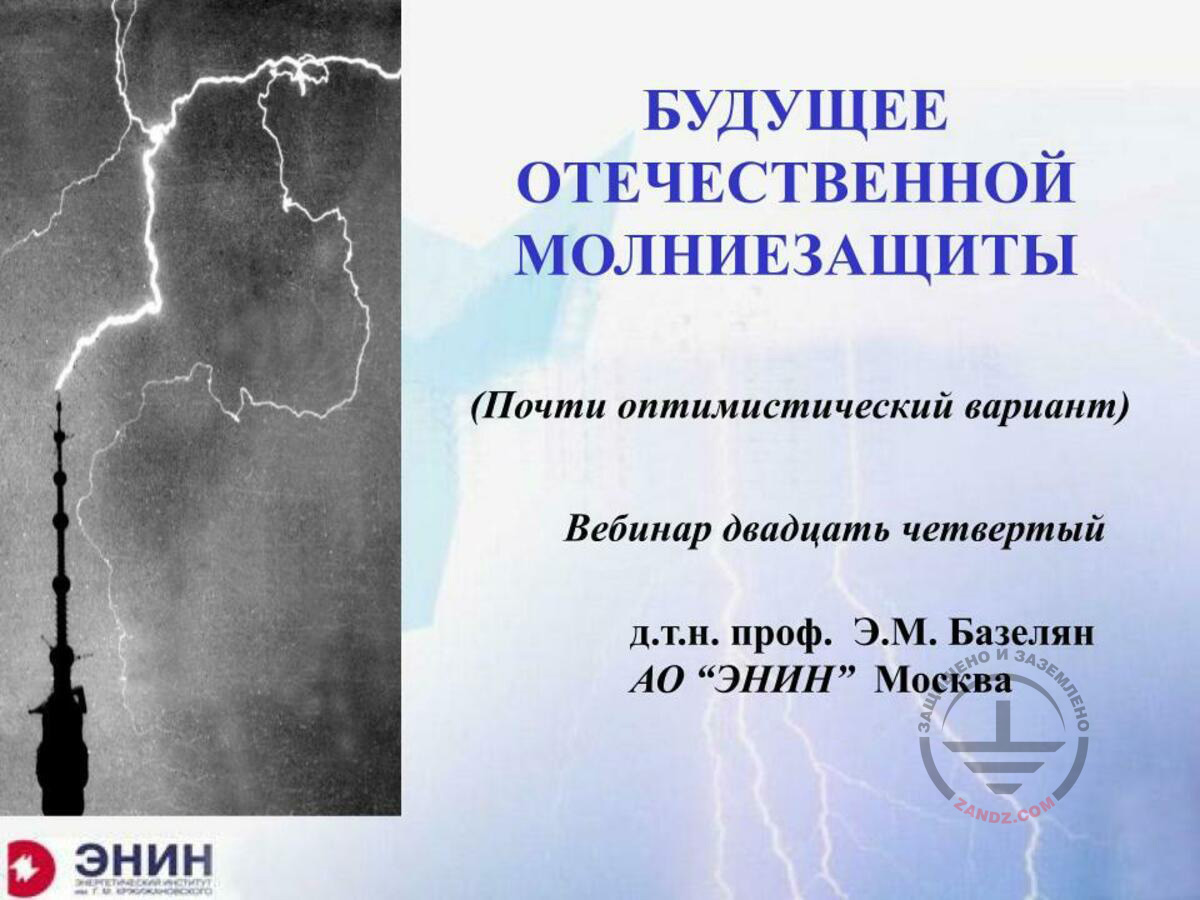
Future of the Russian lightning protection
БУДУЩЕЕ ОТЕЧЕСТВЕННОЙ МОЛНИЕЗАЩИТЫ
(Почти оптимистический вариант)
Вебинар двадцать четвертый
Д.т.н. проф. Э.М. Базелян
АО «ЭНИН» Москва
FUTURE OF THE RUSSIAN LIGHTNING PROTECTION
(an almost optimistic variant)
The twenty-fourth webinar
Dr.Sc. (Eng.), Prof. E.M. Bazelyan
“ENIN” AO, Moscow
– Dear colleagues, good afternoon or good morning to all of you! Let's begin. Good afternoon, Eduard Meerovich!
– Good afternoon, Anatoly!
– Today, we have a webinar titled "Future of the Russian lighting protection (an optimistic variant)". Today, we have a final webinar conducted this year that will be led by Eduard Meerovich. The next webinar of Eduard Meerovich will be held in February and in March. It will be titled "Features of Lightning Protection in Mountains". As soon as we determine the dates and the webinar announcement, we will publish the information on the website and inform you so that you could register. Let me also remind you that the next webinar of the series of webinars dedicated to the BIM design, which is also a final webinar in this series and in 2018 in general will be held on December 18. I will send the link to this webinar in the chat so that you could register for it if you have not done it yet. So, register and take part in our next webinar. Moreover, you may get the information on the events in the social media groups. I will also send the links to them in the chat. Those who have not yet joined our groups, subscribe to us. We publish regularly the information on events, on calculations, and other interesting news in the social media. The links are in the chat, follow them. Here are some organizational aspects: our webinar today will take 60 minutes plus questions and answers. I ask you to be active, ask questions and leave your comments in the chat. I ask you to write your questions in the "Questions" tab specifying the speaker's phrase or slides it refers to. I will also answer the question regarding the webinar video. It will be available, we will publish it immediately after processing at the website and in our YouTube channel. I will also send the link to the chat in case someone needs it. I have finished the introductory word and I give my turn to the speaker. Eduard Meerovich?
– Anatoly, may I add a little about future seminars? I ask my colleagues to ignore the fact that I will talk about the lightning protection in Pamir, Tyan-Shan, or Everest. I will talk about the irregular terrain, wherein such irregularities are created by either nature or human activities, i.e. when there are some forest or construction irregularities around the facility, or some hills. That is what I will talk about. This issue is not clear, but we have to make it clear. It is the first aspect. And now I ask participants not to think of me as a modern Jules Verne. I do not claim to predict the future of the lightning protection some day after tomorrow. I will talk about the things we really had to do yesterday so that we could live more or less well. I am not going to provide some long-term prediction and I cannot do that. I have lived through the technical revolution from its beginning till the end. And I know how hard it is to predict in a long term in these conditions. You know, I remember when I was thirteen and I stood on the chair with my ear being leaned again the black speaker. Nearby, on a similar chair, my grandmother, Ekaterina Fedorovna, stood with her ear leaned against the other side of this speaker. We listened to the radio translation from the Moscow Art Theatre and we were delighted with the fact that we lived in a small town in Moscow Region in our house, and thanks to the technical progress we could actually be in this theatre at the same time. Can you see that? And we felt great. And in five more years, as I remember, I sat with a young and beautiful lady that I have been living with for over 60 years, and there were so many people in that room and nobody paid attention to us. We could even kiss because everybody looked at a small illuminating spot. It was a KVN tv set, and Radj Kapur sang a song about a tramp. And everybody were delighted with the idea that we could be at home and watch a new movie.
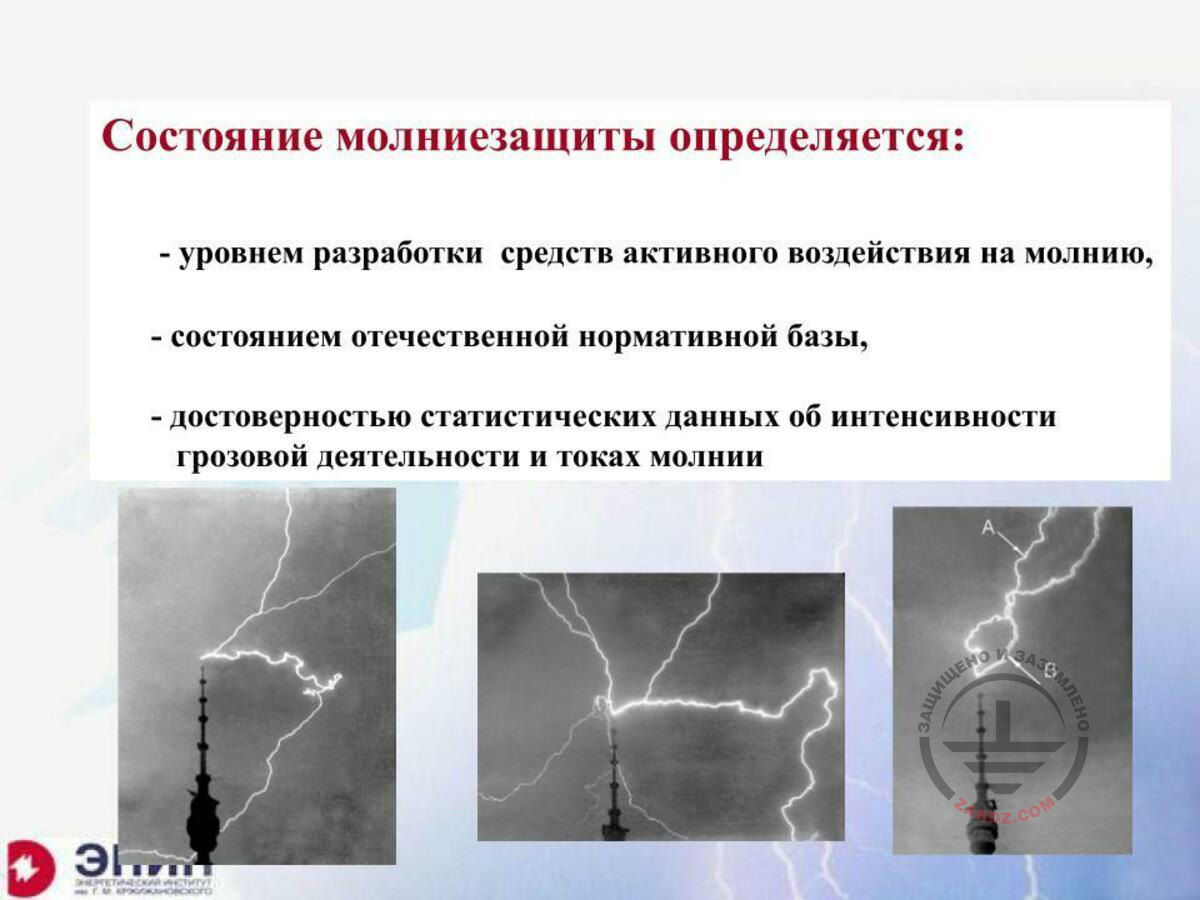
Lightning protection state is determined by
Состояние молниезащиты определяется:
- уровнем разработки средств активного воздействия на молнию,
- состоянием отечественной нормативной базы,
- достоверностью статистических данных об интенсивности грозовой деятельности и токах молнии
Lightning protection state is determined by:
- the level of development of the means of active exposure to the lightning,
- the state of the Russian regulatory framework,
- the accuracy of the statistical data on the storm intensity and lightning currents.
I think that the condition of our lightning protection is determined by three positions. The first position is more or less clear. It is a level of development of technical equipment that allows managing the lightnings. And I am telling you one thing that we are talking about low-energy effects because it is unreasonable to use high energy for lightning protection. And two other points do not seem to be proved. First, we are talking about our Russian regulatory framework, and second, about the reliability of the lightning data collected in the world. If you consider these three aspects, you may understand where the lightning protection will go, if it will, which cannot be excluded. And I set this task which I will try to solve together with you.
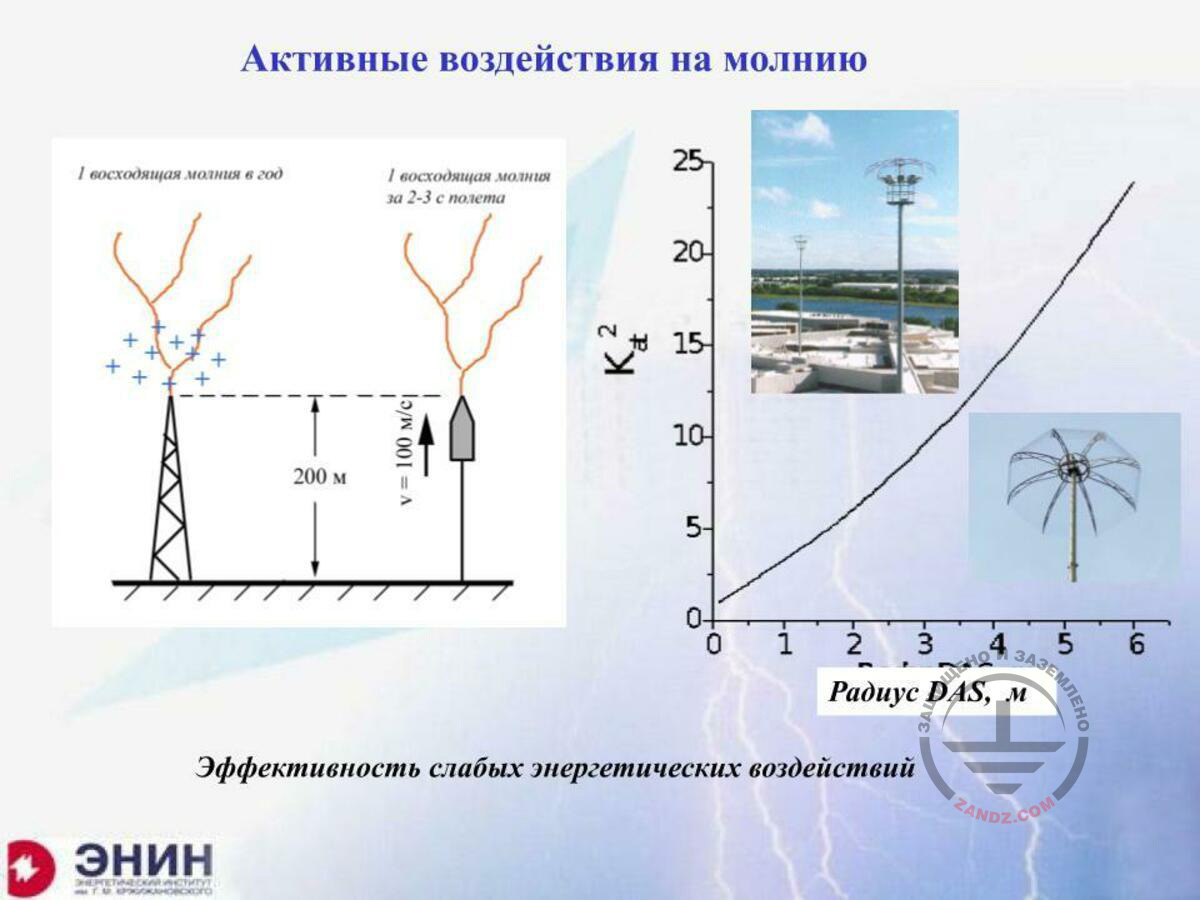
Active impact on the lightning
Активные воздействия на молнию
1 восходящая молния в год
1 восходящая молния за 2-3 с полета
м/с
Радиус DAS,м
Эффективность слабых энергетических воздействий
Active impact on the lightning
1 upward lightning per year
1 upward lightning for 2–3 s of flight
m/s
DAS radius, m
Efficiency of low energy effects
The first point is: can we, in principle, manage the lightning with low energetic impacts? The answer to this question is single and positive. What are the reasons? They are simple. Imagine the tower that is installed on the ground. For example, let it be a TV tower of 250 to 300 meters; it is a standard TV tower in the regional towns. Everybody know that this tower during the thunderstorm season will take at most 3 or 4 lightning strikes. Although storm activity in this region is not less than 40 storm hours. And now the well-known experiment: we take the meteorological rocket, launch it vertically, and it takes an earthed wire with it. When this rocket goes up to the height of 200 to 250 meters, a lightning strike occurs. For 5 seconds of the flight with a reliability of about 70%. What is the difference? The difference is that in front of the tower, due to the crown discharge from its top, there is a cloud of a bulk charge that shields the tower.
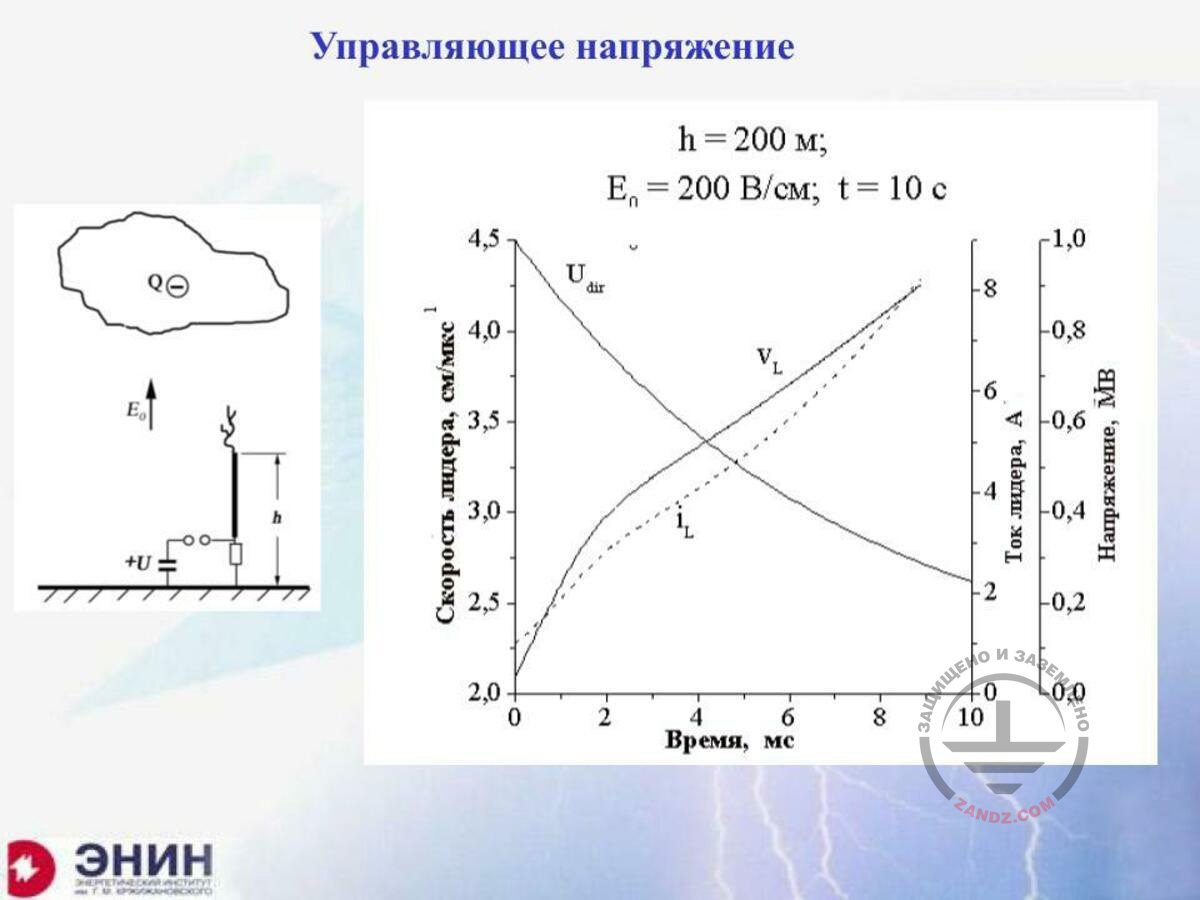
Managing voltage
Управляющее напряжение
м
В/см
Скорость лидера, см/мкс-1
Время, мс
Ток лидера, А
Напряжение, МВ
Managing voltage
m
V/cm
Leader speed, cm/mcs-1
Time, ms
Leader current, A
Voltage, MV
And now, let's talk about some particular issues. The first point that goes to our minds is the following: I have a lightning arrester, it has been earthed before, and now I supply a high voltage relative to the earth to this lightning arrester. In general, all active lightning rods are created on this principle, and we have no doubt in that such system will operate. There is a different question: how much should we supply and for what time? We have an unambiguous answer to this question. The answer is: supply a voltage with the order of magnitude close to a million, half a million volt at most, and keep this voltage for at least half a millisecond so that a conductive plasma channel, a leader, would develop due to this voltage. And this plasma channel by breaking through the layer of the bulk charge would go closer to the lightning and begin attracting it. This method is well known and does not cause any doubts. The question is: how much will it cost? And therefore, people for some reason think that this method is not very suitable. It is a different thing to use laser instead of high voltage. Such laser that will provide a good spark in the SOI system will probably attract a lightning.
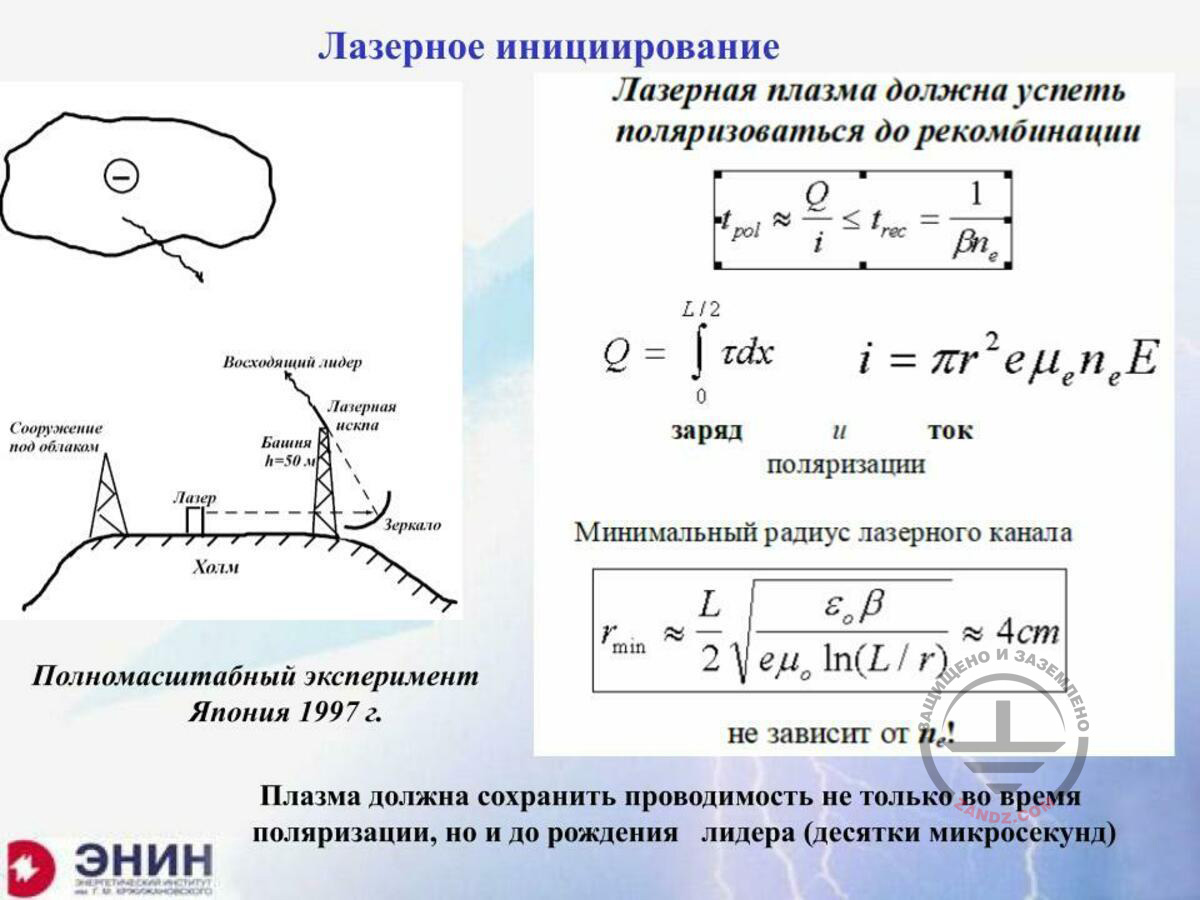
Laser triggering
Лазерное инициирование
Лазерная плазма должна успеть поляризоваться до рекомбинации
Заряд
И
Ток
Поляризации
Минимальный радиус лазерного канала
Не зависит от ne!
Сооружение под облаком
Восходящий лидер
Башня
Лазерная искра
Зеркало
Холм
Полномасштабный эксперимент
Япония 1997 г.
Плазма должна сохранить проводимость не только во время поляризации, но и до рождения лидера (десятки микросекунд)
Laser triggering
Laser plasma should have enough time to polarize before recombination
charge
and
current
of polarization
Minimum radius of a laser channel
does not depend on ne!
A structure underneath the cloud
Upward leader
Tower
Laser spark
Mirror
Hill
Full-scale experiment
Japan 1997
Plasma must retain its conductivity not only during polarization but also before the leader formation (dozens microseconds)
The Japanese did it in the end of the previous century. They installed a 50-meter high tower on the hill. They mounted a CO2 laser near this tower, which had a power that is about equal to that of the SOI laser. And then, they used an ultraviolet laser for this laser illumination. Why? The point is that the laser plasma is cold. In the cold plasma, electrons are rapidly sticking and disappearing. But you need time to grow the conductive channel, and this channel should have time to polarize in the electrical field. And the time of several seconds is needed, whereas seconds in the cold plasma are enough for all electrons to stick and turn into the almost immovable negative ions. And to break these ions and return the electrons back to plasma, illuminate with a CO2 laser, and also illuminated with an ultraviolet laser. And the Japanese did that for 2 years. I have read the scientific report of the Japanese written in English, and I have found the following: they have some certainty that for 2 years of such work, they attracted probably two lightning strikes to this tower. Now, calculate the cost and the level of maintenance complexity, and think what you can do with this.
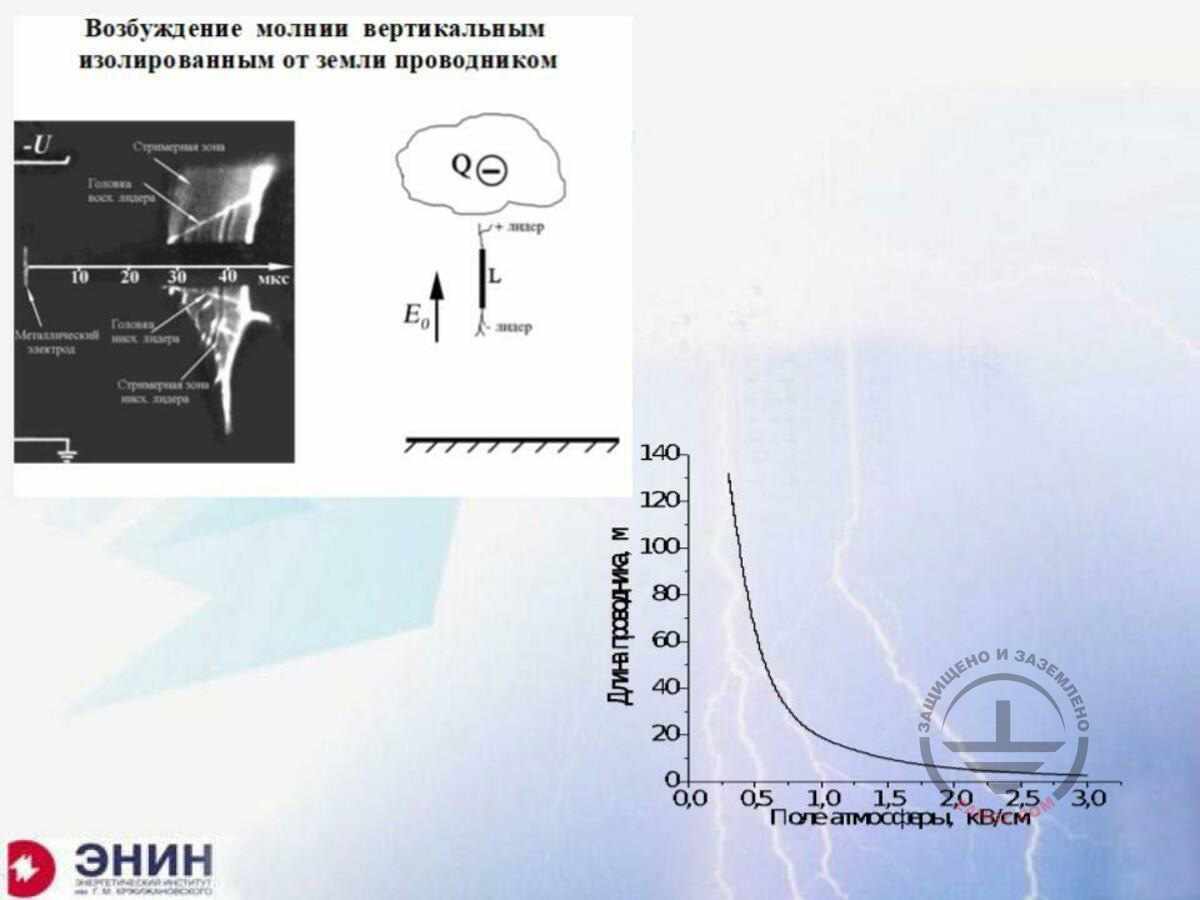
Lightning excitation using a vertical conductor
Возбуждение молнии вертикальным изолированным от земли проводником
+ лидер
- лидер
Длина проводника, м
Поле атмосферы, кВ/см
Lightning excitation with a vertical conductor isolated from the earth
+ leader
- leader
Conductor length, m
Atmosphere field, kV/cm
Let's proceed. Can we make any conductive formations in the space in front of the lightning arrester, towards the moving thunderstorm front? The easiest thing you can do is to throw some metal objects, and if it is difficult to throw them, then you can, e.g., fire a pyrotechnic cartridge that ignites and makes hot plasma. And the question is: can we catch the lightning discharge this way? Can we do that? We can! What length should these plasma formations have? It turns out that the length of these plasma formations depends on the fact to what storm electrical field you will throw this conductive stick or plasma formation that will be created using the pyrotechnical cartridge. If it is about the same as the field near the earth, for example, 0.5 kV per 1 cm or about 1 kV per 1 cm, then this stick must be about 100 meters long. If this field gets stronger, for example, 2 to 4 kV per 1 cm; in this case, the stick size is reduced but it cannot be less than 10, 20, 30 meters anyway.
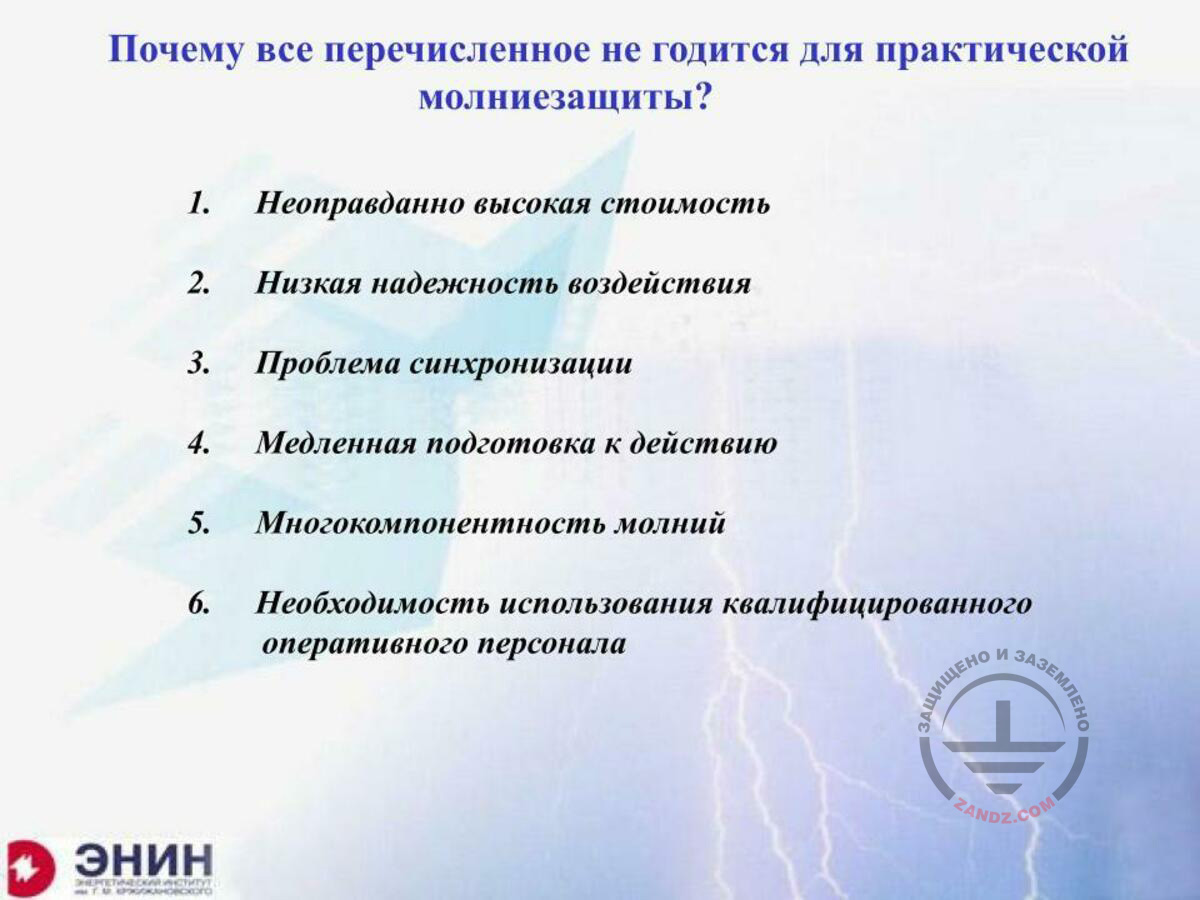
All of the above is not suitable for lightning protection
Почему все перечисленное не годится для практической молниезащиты?
1. Неоправданно высокая стоимость
2. Низкая надежность воздействия
3. Проблема синхронизации
4. Медленная подготовка к действию
5. Многокомпонентность молний
6. Необходимость использования квалифицированного оперативного персонала
Why all of the above is not suitable for lightning protection?
1. Unreasonably high value
2. Low impact reliability
3. Synchronization problem
4. Slow preparation for the action
5. Multicomponent lightning
6. Need to use the qualified operating personnel
And we have one more major point. You have to throw this stick, in general, rather quickly. Such stick must move with the speed of at least 20 meters per second. If you throw it, you will be able to catch a lightning. If you move it slowly, it will be coated with the charged particles due to the crown, and the stick will be shielded by the charge bulk, and you will obtain nothing good as the result. Unfortunately, all I have described can be used for the lightning research. But in the practical lightning protection, it cannot be actually used. Why? We have to discuss it seriously. You know, my teacher, professor Razevig, when he read a lecture for us, said that it is not a problem for the modern science, e.g., to change the water of the Pacific ocean with the water of the Atlantic ocean, but two questions arise: first, what do we need that for, and second, how much will that cost? So, how much will that cost? How much will the device for half a million volts cost? It will be several hundred times more expensive than a conventional lightning rod. But the most essential point is that this device will not be used for a very critical facility. Not because of its high value. It is OK with it, our country can take such cost, if needed. The point is that the reliability of this device is very low. Why? We have to not only supply the voltage at any moment, we have to supply it only when the lightning discharge is reaching us. It means that I have to synchronize the operation of high voltage source with the lightning that is approaching me. And in the respective moment when it becomes really dangerous for me, I must supply this high voltage to the lightning arrester. How can I synchronize this device? Only for the electrical field. But the essence of the charges that differ by two orders of magnitude, and the synchronization issue will be extremely difficult, and it will certainly miss. And the reliability I need is at least 0.99, i.e. out of hundred impacts, 99 must be normal. This is the first problem. The second problem is: how quickly my device should be prepared for the next action? It looks like there is no problem because 3–4 lightning strikes per year, on average, strike 1 km2 of the earth surface. Nothing like that. Please remember that, according to our current statistics, at least 80% lightning discharges are multi-component. It means that in a single lightning flash, five, six or even ten or twenty components go one after another. And these components very often go not along the same path, but along different paths. And the pauses between these components are less than 100 ms, less than 0.1 s. And it means that my device must trigger for each component. But if it triggers for each component, it has to charge for at least one tenth of a second. If I achieve such speed, then my device will be, first, powerful in terms of energy, and second, very expensive. And finally, where can we find the qualified personnel that will manage all these things?
Next page >>
slides from 8 to 14
Related Articles:
 Lightning Protection of Large Territories: Parks, Grounds, Plant Territories. Page 1
Lightning Protection of Large Territories: Parks, Grounds, Plant Territories. Page 1
 Lightning Protection of Large Territories: Parks, Grounds, Plant Territories. Page 2
Lightning Protection of Large Territories: Parks, Grounds, Plant Territories. Page 2
 Lightning Protection of Large Territories: Parks, Grounds, Plant Territories. Page 3
Lightning Protection of Large Territories: Parks, Grounds, Plant Territories. Page 3

